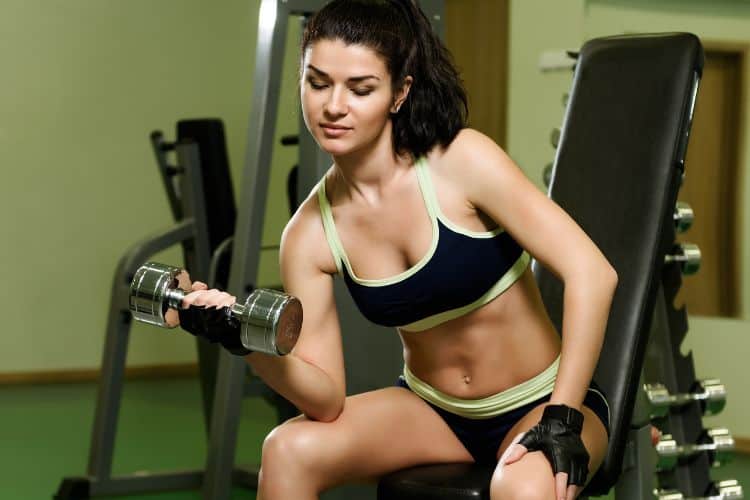Sign up for workout ideas, training advice, reviews of the latest gear and more.






Strength training for women has gained popularity over the years, with women embracing the benefits of weightlifting for improved muscle tone, strength, and overall fitness. Among the most effective exercises for developing upper body strength is the dumbbell shoulder press. This exercise targets the shoulders, enhances core stability, and contributes to improved posture. Whether you’re a beginner or an experienced lifter, the dumbbell shoulder press can be tailored to fit your fitness level and goals. In this guide, we will dive deep into the benefits, proper form, variations, and common mistakes associated with this powerful exercise.
The dumbbell shoulder press is a compound movement that primarily targets the deltoid muscles of the shoulders. It also engages the triceps and upper chest, making it a fantastic upper body exercise. Unlike the barbell shoulder press, which requires both arms to move in unison, the dumbbell variation allows for a greater range of motion and can help correct muscle imbalances between the arms.
In this exercise, you hold a dumbbell in each hand and press them overhead while keeping your body stable. The movement can be performed while seated or standing, depending on your fitness level and goals. Regardless of the variation, mastering the dumbbell shoulder press is essential for anyone looking to build shoulder strength and sculpt a defined upper body.
The primary benefit of the dumbbell shoulder press is increased shoulder strength. This exercise targets the deltoids—specifically, the anterior (front), lateral (middle), and posterior (rear) heads. Strengthening these muscles not only enhances the aesthetics of your shoulders but also improves your ability to perform other strength exercises, such as push-ups, bench presses, and overhead lifts.
Many women struggle with poor posture due to prolonged sitting or hunching over devices. The dumbbell shoulder press helps to correct this by strengthening the muscles that support the shoulders and upper back. As your shoulder muscles grow stronger, they contribute to better alignment, helping you maintain a more upright posture throughout the day.
Functional fitness refers to exercises that mimic real-life movements, and the dumbbell shoulder press is a great example. This exercise mirrors the action of pushing or lifting objects overhead, which can be useful in everyday life. Whether you’re lifting groceries, carrying your child, or placing items on a high shelf, building shoulder strength through the dumbbell press can make these tasks easier.
The dumbbell shoulder press requires more than just shoulder strength; it also demands core stability. When performing this exercise, especially while standing, your core muscles are activated to maintain balance and prevent your body from swaying. This engagement strengthens your abs and lower back, contributing to a strong, stable core.
One of the key advantages of using dumbbells instead of a barbell is that each arm works independently. This unilateral movement helps prevent muscle imbalances, ensuring that one arm does not compensate for the other. Over time, this balanced strength development leads to more symmetrical muscle tone and improved overall strength.
Before diving into variations and advanced techniques, it’s crucial to master the basic form of the dumbbell shoulder press to maximize effectiveness and minimize the risk of injury.
To keep your workouts challenging and engaging, try incorporating different variations of the dumbbell shoulder press. Each variation targets your muscles slightly differently, allowing you to achieve more balanced strength and muscle development.
In the seated variation, you sit on a bench with a backrest, which helps stabilize your torso and reduce the involvement of your lower body. This version is ideal for beginners or those who want to focus purely on shoulder development without engaging the core as much.
Standing adds an additional layer of difficulty as it requires more core activation to maintain stability throughout the movement. This version is excellent for those looking to engage their entire body while working the shoulders.
The Arnold press is a variation named after Arnold Schwarzenegger and involves a slight twist in the movement. This variation targets the anterior and lateral deltoids more effectively, providing a well-rounded shoulder workout.
This variation works one arm at a time, which increases core engagement and helps identify any strength imbalances between the arms. The single-arm dumbbell shoulder press is also beneficial for improving stability and balance.
The push press incorporates a slight bend in the knees to generate momentum from your lower body, making it easier to press heavier weights overhead. This explosive movement targets the shoulders while also engaging the legs and core.
Like any exercise, proper form is key to getting the most out of the dumbbell shoulder press and preventing injury. Here are some common mistakes to watch out for:
One of the most common mistakes is arching the lower back during the press, especially when using heavy weights. This can place unnecessary strain on your spine and lead to injury. To avoid this, always engage your core and maintain a neutral spine throughout the movement.
Some individuals use momentum to lift the weights, which reduces the effectiveness of the exercise and increases the risk of injury. To avoid this, focus on using controlled movements and avoid “throwing” the weights overhead.
Locking your elbows at the top of the press places unnecessary stress on your joints and reduces the tension on your shoulder muscles. Always keep a slight bend in your elbows at the top of the movement.
Lifting weights that are too heavy can compromise your form and increase the risk of injury. Start with lighter weights and gradually increase as you build strength and confidence in your technique.
The dumbbell shoulder press is a versatile exercise that can be easily integrated into your existing workout routine. Here’s how to structure your training to get the most out of this exercise:
As a beginner, focus on mastering proper form and gradually increasing the weight as your strength improves.
At this level, you can begin to incorporate different variations, such as the Arnold press or push press, to target different parts of the shoulders.
For advanced lifters, consider incorporating supersets with other upper-body exercises, such as lateral raises or bent-over rows, to create a more challenging workout that pushes your muscles to fatigue.
The dumbbell shoulder press is a foundational exercise for building strong, sculpted shoulders and improving overall upper-body strength. For women, this exercise offers a range of benefits, from enhanced posture to increased functional fitness. By mastering the proper form, incorporating variations, and avoiding common mistakes, you can make the dumbbell shoulder press a key component of your strength-training routine.
Whether you’re lifting to improve your health, sculpt your physique, or boost your athletic performance, the dumbbell shoulder press will help you achieve your fitness goals with confidence.
Stay up to date on the latest women’s health, fitness and lifestyle trends and tips.